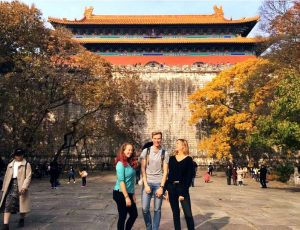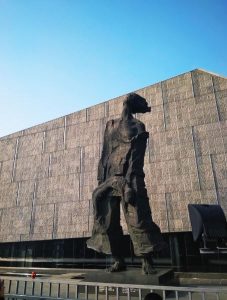我决定去南京躲避北京冷的天气而且发现中国以前的首都的历史和名胜古迹。我只有两天,所以应该充满了活动。南京因很好吃的食品而著名。 夫子庙的附近充满着小摊子,都卖各种各样的小吃,比方说 鸡汤油炸云吞、牛肉锅贴(秦淮八绝之一,南京最好好吃的菜)。可是虽然特别有名,我不敢吃老鸭粉丝汤!

The mouth-watering local delicacies
虽然南京古代历史很丰富, 现代历史比较坎坷:在20世纪发生所有的事当中,我认为第二次世界大战的南京大屠杀是最辛酸的。侵华日军南京大屠杀遇难同胞纪念馆是优美环境与悲怆历史的辛酸结合。可惜,我到了,发现了纪念馆为维护而关门。可是在纪念馆的外面,有很多雕像, 表现辛苦的样子,让参加的人感动。刻着在雕像的下的诗歌表达对大屠杀的看法:无望、不公正和生存竞争。
中山陵也是非常有名的。孙中山(1866年-1925年)是中华民国的奠基人。作为奠基人和中华民国的第一个领导人,在中国他被称为‘中国近代民主革命的伟大先行者’ 而且在台湾,被称为‘中华民国国父’。辛亥革命之内,孙发挥很重要的作用:辛亥革命颠覆了清朝。清朝颠覆以后,孙设法统一全国,因此在20世纪中国政治家当中,他是唯一在台湾海峡的两边尊敬的人。不过,中山陵的流行度却导致问题:我到售票处的时候, 问门票多少钱,回答是‘免费’ !所以我很开心地走到入口 (离售票处45分钟的走路),发现了有自动转闸机:以前的售票员没告诉我应该扫一扫一个在售票处旁边的二维码来预定‘免费’的门票!因此,不能进入。
然而,明孝陵景区离中山陵不太远,所以我决定参加:明孝陵特别隆重。可是最喜欢的是到明孝陵景区的步道:弯弯曲曲的登山步道都是非常漂亮的。除了听到虫鸣鸟叫,也看到红叶随着风飞舞。呼吸着新鲜的空气,让我觉得身心舒畅无比。环境真美好,让人流连忘返。而站在紫金山的山顶向远处眺望,一望无际的视野更使我心胸开阔。那是真的一次难忘的旅行。

The rather impressive Ming tombs towering up in the background!
I decided to go to Nanjing in order to escape the cold weather of Beijing and also to visit the famous historical sites of China’s former capital. I only had two days there so I packed it full of activities. Nanjing is famous for its food, and in the surrounding areas of the Confucius temple, there were lots of stalls selling local snacks. For example, there was deep fried chicken wonton, and beef pot-stickers (one of the eight ‘ Qinhuai treasures’, the best dishes in Nanjing). However, although duck blood soup is renowned throughout China, I decided against trying it!
Although Nanjing is rich in ancient history, its modern history is rather more tumultuous. Out of all the events that occurred in the 20th century, the Nanjing Massacre of the Second World War is the most poignant. The Nanjing Massacre Memorial is the emotional combination of beautiful scenery and tragic history. Unfortunately, when I arrived, I discovered that it was closed for repairs. Nonetheless, the outside of the memorial had lots of statues, all with very pained expressions, making all the tourists feel greatly moved. Engraved underneath the statues were poems expressing the ‘statues’ view of the Nanjing Massacre: the hopelessness, the injustice and the struggle to survive.

One of the heart-rending statues outside the Nanjing Massacre Memorial
The Sun Yat-Sen Mausoleum is also very famous. Sun Yat-Sen (1866-1925) was the founder of the Republic of China. As the founder of the Republic of China and its first leader, in The Republic of China he is called the ‘Pioneer of Democratic Revolution’ and in Taiwan, ‘The Father of the Country’. During the Xinhai Revolution, he played a very important role (the Xinhai Revolution overthrew the Qing Dynasty). After the Qing were overthrown, Sun tried to unite the whole country, thus of all the 20th century politicians, he is the only one who is respected on both sides of the Taiwan strait. But the popularity of the mausoleum causes problems: when I went to the ticket office and asked how much the entry price was, I were told it was free entry. I happily walked to the entrance (45 minutes away from the ticket booth) only to discover that there were turnstiles: the worker in the ticket office didn’t tell us I needed to reserve an entry time by scanning the QR code next to the office. Consequently, I couldn’t get in.
Nonetheless, the Ming tombs weren’t too far from the mausoleum, so I decided to visit them. The Ming tombs were very grand, but what I enjoyed the most was getting to the Ming Tombs. The winding paths were especially beautiful: apart from hearing the buzzing of insects, I also saw the red leaves dancing on the wind. Breathing in the fresh air made me feel so at ease that I wanted to stay for longer! Also, when I reached the top of Zijin Mountain and looked out into the distance, the endless view was just spectacular. It truly was an unforgettable trip!
